 |
||
|
||
| ||
Part 3: Performance in Game Tests
TABLE OF CONTENTS
So we have come to the main part of this article, when the X1900 XTX reveals its results in gaming tests. Those games... Everything is sacrificed to them: money, time, health... Thousands of minds in Toronto, Santa-Clara (maybe somewhere else, but working under cover) work, think, invent, apply, bring to grass... All their efforts are for gamers. Yep, for their sake programmers strive to make the water look wet, leaves not to look like plywood, wet cold stone surface in caves not to look like painted on a sheet of cardboard... They strive to create 3D graphics so that gamers wanted to enter their monitors and get there.. Into virtual reality.
So let's stop being lyrical and start the analysis. It's no secret that many games have already reached the limits of CPU and system capacities on the whole, so we don't see the potential of top video cards even in AA 4x and AF 16x modes. That's why we introduced a new HQ (High Quality) mode, which means:
HQ:
It's the maximum that can be demonstrated by all accelerators. That is their capacity is used nearly by 100%. Even considering different implementations of AA and AF, their high quality is approximately the same.
Test results: performance comparisonWe used the following test applications:
Considering the capacity of the latest generation of accelerators, performance analysis should be performed only with the AA+AF load. Otherwise, it would be a competition of processors or system units rather than video cards. Sometimes in HQ mode only. Of course, in heavy applications, where powerful video cards demonstrate mediocre performance even without AA+AF, we shall analyze these modes as well. Game tests that heavily load vertex shaders, mixed pixel shaders 1.1 and 2.0, active multitexturing.FarCry, Research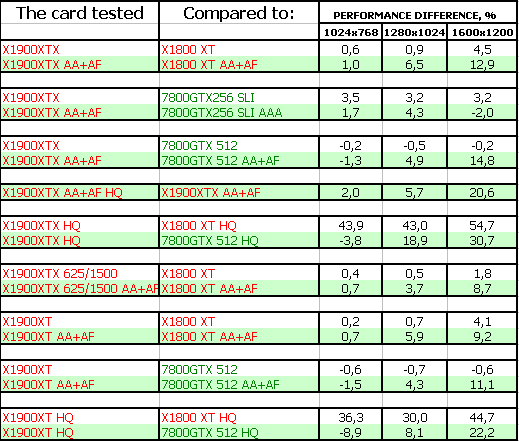 This game is limited by system resources, so it will be right to evaluate it in the HQ mode. This card demonstrates brilliant results in this mode! Powerful advantage over the former leader (X1800 XT) and over the competing GeForce 7800 GTX 512MB. It also has some victories in regular conditions with AA4x+AF16x. Note that we haven't enabled HDR yet. Official Patch 1.4 will be out soon, which will enable this function for the X1xxx series. It will be interesting to compare our results with HDR. The 1900 XT is doing great! It also outperforms its competitors, even though it's cheaper than the 7800 GTX 512MB!
Game tests that heavily load vertex shaders, pixel shaders 2.0, active multitexturing.F.E.A.R. Well, what can I say? The heaviest game for accelerators these days reveals the true status quo. It's obvious that even the HQ mode in this game can be enabled only in 1024x768, or the game will be too slow even on the most powerful accelerator. We can see here that the new product from ATI outperforms its competitors and the previous products by 50% and higher! Taking into account that this game requires really huge computational resources from an accelerator in the first place and only then texturing capacities, the new R580 architecture acts brilliantly here. Of course, the number of ROPs and TMUs is a deterrent, so there is no manifold advantage (there are three times as many pixel pipelines as in the R520, two times as many as in the G70). But it's still impressive. But NVIDIA speaks of a mistake in the latest releases of its drivers and promises to raise its performance (ATI had the same situation a couple of months before). We'll see. By the way, the same can also be said about the X1900 XT! Especially considering that its price is slower by $100 than for the top model.
Splinter Cell Chaos Theory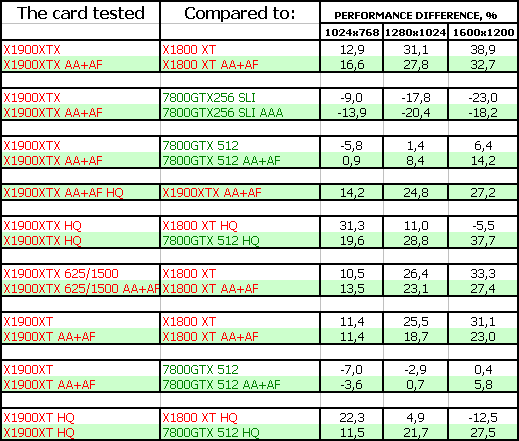 This game is also heavy for accelerators, but not to the same degree as the previous game. Nevertheless, the X1900 XTX in AA4x+AF16x modes demonstrated very good results. The advantage is again not manifold - texturing plays important role in this case. But we can see miracles in the HQ mode. Advantage over GeForce stands to reason. But it's not clear why the competition with the X1800 XT ended in defeat in 1600x1200. Problems with drivers most likely. Or probably HQ is not enabled to the full in one of the cards. It's very difficult to check this assumption - the entire game is dark.
Half-Life2: ixbt01 demo
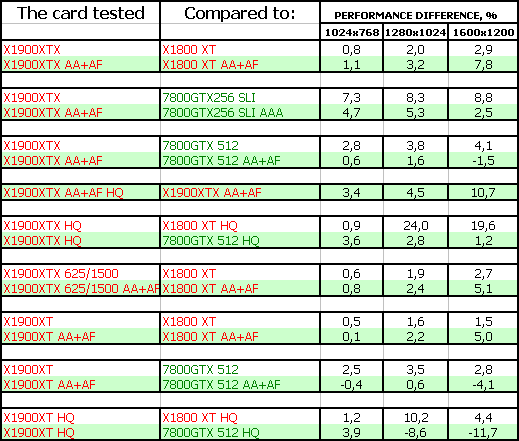 This test is limited by CPU capacities more than Far Cry, so we are interested only in HQ mode. Here we can see that the game has a previous-gen engine, where texturing and computational capacities of shader pipelines are used on equal grounds, hence almost no advantage over the X1900 XTX. It fairs well against the X1800 XT, but that's only due to its higher frequency, optimal caching, etc. Triple shader capacities are of little help here. We can see that the famous hobby horse of NVIDIA (efficient operations with textures) has put the X1900 XTX on the same level with the GeForce 7800 GTX. And the 1900 XT is even outperformed. But I repeat that it's a bright example of a passing generation of games. If the game had had HDR and Shaders 3.0, the X1900 XTX would have risen sky high, as the XT model.
Game tests that heavily load pixel pipelines with texturing, active operations of the stencil buffer and shader unitsDOOM III High mode Chronicles of Riddick, demo 44
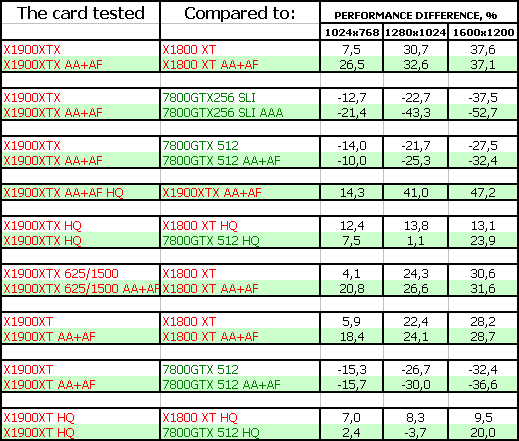 Alas, OpenGL is again Achilles' heel of ATI's products. However, the problem is not only in API. Everybody knows that DOOM III and its engine are fine-tuned for NVIDIA cards (texture operations, stencil buffer, etc). That's why all GeForce cards can be victorious here, there is no reason to be surprised. Nevertheless, if we enable HQ, such a load miraculously turns all the victories of the GeForce 7800 GTX into defeats. The X1900 XTX as well as the 1900 XT shoot forward. The gameplay is not very good, but we should keep in mind that resolutions higher than 1024x768 are useless.
Synthetic tests that heavily load shader units3DMark05: MARKS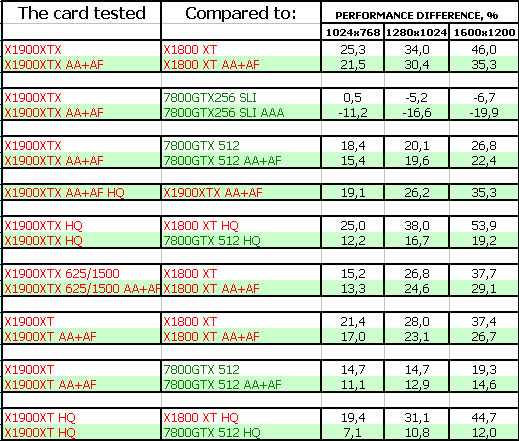 To make 3DMark05 working in HQ mode is something... I speak of GeForce. NVIDIA did an unpleasant thing: forcing won't work, if an application can enable AA. What a silly solution! What if an application is old and doesn't know anything about modern excellent AA modes available in drivers? They won't work or they will, but... you'll have to sweat it to enable them. Nevertheless, the X1900 XTX is obviously victorious, but not manifold again. Even less than by 50%. But texturing still plays a very big role even in such a super-shader test, its computing/texturing requirements ratio is far from 3-to-1.
Performance conclusions
ATI RADEON X1900XTX is evidently a new 3D graphics king. That's indisputable and out of any doubts. Taking into account that GeForce 7800 GTX 512MB is not available on sale yet (but NVIDIA promises to start shipments), if the X1900 XTX appears on the shelves right after the announcement, it will become the most wanted product for fans and enthusiasts, who are ready to spend any sum of money for the most powerful accelerator. The new top product from NVIDIA must be launched in early March. We don't know anything about it so far, the battle will come up with a bang in early spring. As for now, the round is won by the Canadian company. I hope that the company will keep the promise to start sales right after the announcement and that such an opportunity will be given not only to customers in Canada and the USA, but also in Russia. What concerns the expedience of the new 3:1 formula accepted in Toronto (computing:texturing) - we have grounds to expect it bear some fruit. We can see that the newer the games, the more requirements they pose to shader computations. And vice versa, the older the game, the paler the efficiency of the X1900 XTX. It's obviously foolish to buy such a card for playing Quake3 or Serious Sam 1. I also want to note that the efficiency of Shaders 3.0 in terms of (dynamic) branching is manifold higher in the X1900 XTX than in the competitor from NVIDIA, which may also have a positive effect in future games. But there is still one question remaining: how well will SM 3.0 be used in the light of the nearest appearance of DX Next (MS Vista), when games and engines have to be developed in a totally different way. Low dynamic branching performance in Shaders 3.0 in NVIDIA, as the main and only recent owner of these technologies, led to reluctant introduction of SM 3.0 into games. Even despite the texturing features in vertex pipelines, which are not available in the X1xxx. The time will show who was right. ATI RADEON X1900XT is probably a more interesting product, differing from its elder brother by just 25 MHz of the core (and its memory frequency is lower by 50 MHz), while its price is lower by $100! That's why we have seen it many times outperform the 7800 GTX 512MB, even being cheaper. The rest of the above said can apply to this product as well. In conclusion I want to congratulate the Canadian company once again with a new successful product and the 3D Graphics throne.
But don't forget that it's a challenge throne, not eternal :) Who wins the next round? We'll be the first to inform our readers! Always stay with us! :)
You can find more detailed comparisons of various video cards in our 3Digest.
Theoretical materials and reviews of video cards, which concern functional properties of the GPU ATI RADEON X1xxx (R520/580/RV5xx) and NVIDIA GeForce 7xxx (G7x)Write a comment below. No registration needed!
|
Platform · Video · Multimedia · Mobile · Other || About us & Privacy policy · Twitter · Facebook Copyright © Byrds Research & Publishing, Ltd., 1997–2011. All rights reserved. |